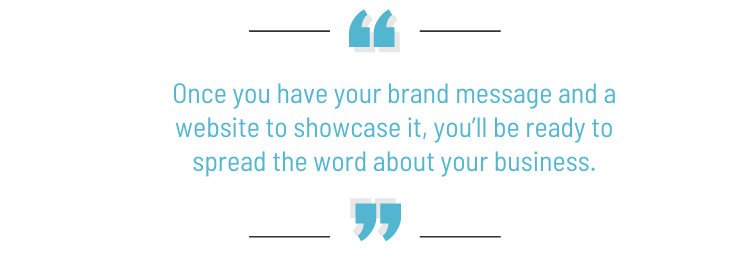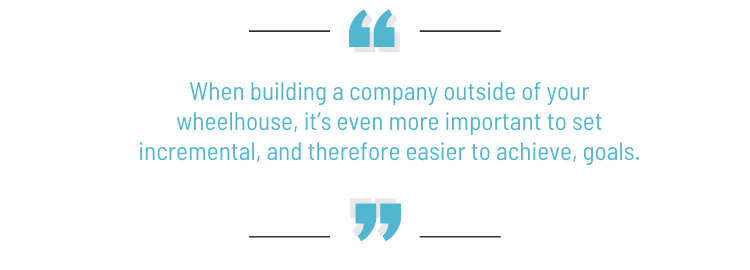
Want to change careers? You’re definitely not alone. That’s why we’ve partnered with Squarespace to create this special four-part series on how to navigate the transition, complete with worksheets to guide you every step of the way. Check out Parts 1, 2, and 3, and read on for Part 4.
Changing careers is one thing. Leaving your job to strike out on your own is another. Doing both at the same time—launching a small business in a different industry and crafting a whole new work identity—is a special kind of challenge (and adventure!). But it most certainly can be done.
For some people, the path to career satisfaction lies not in taking a full-time role in another field, but in creating their own dream job within an industry they are interested in or passionate about. That was the case for John Sheppard, a graphic designer turned ceramic artist. He started taking ceramics classes in his free time, and was hooked immediately. “Over time people told me I should try to sell my work,” he says. “You hear that enough times that you start to believe it, so I set up an online shop on Squarespace.”
After a few years, Sheppard’s hobby was a full-fledged side hustle that just kept growing. “I really loved it, and I looked forward to leaving work and going to the studio,” he says. “That’s when I realized it was time for me to do something different, and the only way to build my side business was to go all in.”

Once you’ve determined you have what it takes to become an entrepreneur, there are some important tips to follow that will put you, and your business, on a path to success. And we turned right to the source for advice: real-life entrepreneurs who used a new business to build a different career. Here’s what they had to say.
1. Do Your Research
When launching a business in an industry you know nothing to little about, the first step is to learn as much as you possibly can about it. It could take months to really become an expert, but the time investment will pay off.
Just ask Jen Clarke. Getting passed up for a promotion at an investment bank is what inspired her to consider other ways to diversify her income. Her and her husband’s big idea: Start a trucking company for delivering items to big-box stores like Walmart. “I knew nothing about the industry, not even what a tractor trailer was,” says Clarke, who had spent more than a decade working in finance and business valuations.
The first thing Clarke did was educate herself—and not just by reading a copy of Federal Motor Carrier Safety Regulations (though she did that, too). “You need to know more than just the high-level information, so I dug deep,” she says. “I wanted to understand the pain points of the industry. Before buying our first truck, I even cold-called brokers who would connect us with loads that needed delivering to get comfortable with how they interact and to get a sense of prices.”
Only once they were armed with knowledge did Clarke and her husband feel comfortable enough to take out a home equity loan and purchase their first truck.
Use our free worksheet to help you launch a business as a career changer; download it here.
2. Make a Plan
There’s no right way to create a plan for your business. It can be a full-fledged strategy, complete with charts and graphs, or a simple to-do list to keep you on track. The most important thing is to have one—especially for first-time business owners, who will especially benefit from having a way to hold themselves accountable.
If you’re a numbers person like Clarke, you could do a pro forma, or an estimated financial statement. “I estimated all of my cash flow and expenses for 12 months to ensure we would be able to execute the business,” she says.
Or you can take a more casual approach. “I didn’t have anything formal written down, but I definitely had a plan,” Sheppard says. “I can’t stress enough how crucial this is. Even a loose roadmap is helpful because it’s easy to get bogged down in the little details or sidetracked by different ideas.”
3. Build Your Online Presence
You can’t own a small business today without having a website to promote who you are and what you do. And when you’re pivoting to a new industry, a site provides you with a place to tell a compelling story about your career path and what led to your new venture.

Here are some things to think about when creating a site:
Have a Message
The first step is to craft the right messaging for your business. “You have to know your core aesthetic or purpose and be able to communicate it in a way that other people will understand and find appealing,” Sheppard says. This includes what you put on your About page, and—if you’re selling products—how you photograph them and write the descriptions.
Choose the Right Tools
According to Sheppard, customers won’t take you seriously unless you have a website that looks and feels professional. For that, he turned to Squarespace. “They made it easy for me to make something really polished,” he says. The website platform has tons of templates to choose from, which users can customize to fit the look and feel of their business.
Zaida Zamorano, who spent many years in marketing and sales—most recently as a sales director for an international watch brand—also knew having a website was imperative. And so was understanding how it worked. In early 2020, she launched not one, but two brick-and-mortar businesses: a children’s event space and ice cream shop called Vida’s (a partnership with her mom) and the jewelry showroom and coworking space The Creative Atelier (co-owned with Caitlin Shockley, a friend who works in public relations).

“None of us had done anything with a website, or SEO, or digital marketing, so we thought it was important to learn everything we could,” says Zamorano, who used Squarespace to build The Creative NYC website (as well as part of their e-commerce site Atelier All Day). “We sent ourselves to bootcamp and took online tutorials.”
Free educational resources, guides, and videos can be found on Squarespace and their YouTube channel for users who need help, including a checklist of SEO best practices and a video series on how to set up an e-commerce site.
Use Your Site to Market Yourself
Once you have your brand message and a website to showcase it, you’ll be ready to spread the word about your business. Sheppard, for example, uses his website whenever he reaches out to shop owners or interior designers, so they can see exactly what he does. “It’s also great for reaching out to press,” he says.

Clarke recently embarked on another business venture that relies heavily on her website to cultivate a community of Black women who are (or want to be) entrepreneurs. “Right now, my website is about educating women about starting businesses,” she says. “I’m using it to help rebrand myself as someone who can share my experience and knowledge.”
4. Don’t Be Afraid to Ask for Help
When launching a business in an industry that’s completely unfamiliar to you, there’s only so much you can learn from books and websites. The best advice will likely come from someone who’s been in your shoes. But don’t think of them as the competition. It’s a mistake Clarke made when launching her trucking company, which now does deliveries for Amazon. “I lost money that I wouldn’t have if I had talked to someone with a similar business,” she says.
For her new business, Clarke did the opposite, and reached out to a variety of entrepreneurial women on social media. “People love to talk about how they did the things they did,” she says. “Plus, you may even find someone who could be a future collaborator.”

Zamorano also regrets not finding an expert to speak to before opening Vida’s, especially when it came to the food and beverage side of things. “I think if I had spoken to a restaurant owner, we would have been more prepared for the unexpected,” she says.
Sheppard, meanwhile, turned to other ceramic artists and designers to get information, such as how to pack and send fragile items so they don’t break. And when he needed advice on public relations, he invited a publicist for coffee. “You’ll find that most people will be happy to sit down and tell you every secret and tip they know,” Sheppard says.
5. Set Realistic Goals
The truth is that success likely won’t come overnight for a new entrepreneur—even one who launches a business in an industry they’ve worked in for years. So when building a company outside of your wheelhouse, it’s even more important to set incremental, and therefore easier to achieve, goals. That way, you know you’ll make headway toward succeeding.

At the onset of starting the trucking company, Clarke and her husband had one objective in mind: to pay for private school for their daughter. From there, they hoped to pay off the truck, buy a second truck, and then pay off the home equity loan they took out. “We were able to accomplish each of these because we set multiple, incremental goals,” she says.
Sheppard, similarly, comes up with an annual list of what he wants to accomplish. In 2020, it was to add five new wholesale clients, contact a certain number of stores, and sign up to attend a trade show. “Things are looking a little different, however, so I’ve been revising them,” he says. “Having more realistic and smaller goals will also make it easier to shift your focus if need be.”
6. Learn How to Value Your Time
If you’re transitioning out of a full-time, salaried position, you may not be used to thinking about how much an hour of your time is worth. But that’s because you’ve likely never been solely responsible for running a business—and when you first launch, chances are good you’ll be doing everything, from accounting to marketing. And while that’s a good way to learn every aspect of running a business, it’ll also take up a lot of your time—time that might be better spent on other tasks.
Clarke eventually realized it made sense to hire human resources and management staff to help oversee the 100-plus drivers she now works with. And Sheppard ended up hiring an assistant to help with production-type responsibilities. “I was nervous at first because of the extra expense, but then realized by spending money, I can take on more business,” he says. “I saw that I could think more ambitiously about future projects instead of having to spend time on things like cleaning brushes.”
7. Be Resilient
Owning your own business is hard work, and it will have ups and downs—and you may take the “downs” harder if you’ve never done it before. Through it all, you need to keep believing in yourself and whatever service or product you are providing. “I have to remind myself that while my work is creative, it’s just a business,” Sheppard says. “Therefore, the rejections I get are not personal. If someone doesn’t want to buy lamps from me, it’s not because the lamps are bad or I’m not a good designer. It’s because they don’t need those lamps.”
Plus, he adds, “For every ‘no,’ there are clients who come back for more. And the good feelings always outweigh the bad.”